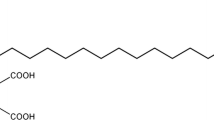Abstract
A noncovalent bonding method is utilized for forming pH-responsive surface active ionic liquids in mixed N-hexadecyl-N-methylpyrrolidinium bromide-based cationic surfactant (C16MPBr) and potassium phthalic acid (PPA). Rheology, cryogenic-transmission electron microscopy, and dynamic light scattering results revealed that the microstructure transition between spherical micelles and wormlike micelles was the fundamental cause of the pH-sensitive rheological properties. In addition, combined with nuclear magnetic resonance and UV–vis analysis, we found that the structure transition of micelles was attributed to different binding abilities of hydrotropes to C16MPBr as pH varies. It is confirmed that the binding ability of PPA to C16MPBr is strongest. This noncovalent bonding method is not only versatile but also economical for fabricating pH-responsive surface active ionic liquids.











Similar content being viewed by others
References
Nagarajan R (2002) Molecular packing parameter and surfactant self-assembly: the neglected role of the surfactant tail. Langmuir 18:31–38
Takacs CJ, Sun Y, Welch GC, Perez LA, Liu X, Wen W, Bazan GC, Heeger AJ (2012) Solar cell efficiency, self-assembly, and dipole–dipole interactions of isomorphic narrow-band-gap molecules. J Am Chem Soc 134:16597–16606
Gazit E (2002) A possible role for π-stacking in the self-assembly of amyloid fibrils. FASEB J 16:77–83
Kalsin AM, Fialkowski M, Paszewski M, Smoukov SK, Bishop KJ, Grzybowski BA (2006) Electrostatic self-assembly of binary nanoparticle crystals with a diamond-like lattice. Science 312:420–424
Lalatonne Y, Richardi J, Pileni M (2004) Van der Waals versus dipolar forces controlling mesoscopic organizations of magnetic nanocrystals. Nat Mater 3:121–125
Simard M, Su D, Wuest JD (1991) Use of hydrogen bonds to control molecular aggregation. self-assembly of three-dimensional networks with large chambers. J Am Chem Soc 113:4696–4698
Lin Z, Cai J, Scriven L, Davis H (1994) Spherical-to-wormlike micelle transition in CTAB solutions. J Phys Chem 98:5984–5993
Kotov N (1999) Layer-by-layer self-assembly: the contribution of hydrophobic interactions. Nanostruct Mater 12:789–796
Cates M, Candau S (1990) Statics and dynamics of worm-like surfactant micelles. J Phys Condens Matter 2:6869
Maitland G (2000) Oil and gas production. Curr Opin Colloid Interface Sci 5:301–311
Lühmann B, Finkelmann H (1986) A lyotropic nematic phase of lamellar micelles (N L) obtained by a non-ionic surfactant in aqueous solution. Colloid Polym Sci 264:189–192
Chu Z, Dreiss CA, Feng Y (2013) Smart wormlike micelles. Chem Soc Rev 42:7174–7203
Maeda H, Tanaka S, Ono Y, Miyahara M, Kawasaki H, Nemoto N, Almgren M (2006) Reversible micelle-vesicle conversion of oleyldimethylamine oxide by pH changes. J Phys Chem B 110:12451–12458
Zhou SL, Matsumoto S, Tian HD, Yamane H, Ojida A, Kiyonaka S, Hamachi I (2005) pH‐responsive shrinkage/swelling of a supramolecular hydrogel composed of two small amphiphilic molecules. Chem-A Europ J 11:1130–1136
Wasungu L, Scarzello M, van Dam G, Molema G, Wagenaar A, Engberts JB, Hoekstra D (2006) Transfection mediated by pH-sensitive sugar-based gemini surfactants; potential for in vivo gene therapy applications. J Mol Med 84:774–784
Dai C, Yan Z, You Q, Du M, Zhao M (2014) Formation of worm-like micelles in mixed N-hexadecyl-N-methylpyrrolidinium bromide-based cationic surfactant and anionic surfactant systems. PLoS One 9:e102539
Cross MM (1965) Rheology of non-Newtonian fluids: a new flow equation for pseudoplastic systems. J Colloid Sci 20:417–437
Kern F, Lequeux F, Zana R, Candau S (1994) Dynamic properties of salt-free viscoelastic micellar solutions. Langmuir : ACS J Surf Colloid 10:1714–1723
Heymans N, Bauwens J-C (1994) Fractal rheological models and fractional differential equations for viscoelastic behavior. Rheol Acta 33:210–219
Rehage H, Hoffmann H (1988) Rheological properties of viscoelastic surfactant systems. J Phys Chem 92:4712–4719
Baumgaertel M, Winter H (1992) Interrelation between continuous and discrete relaxation time spectra. J Non-Newtonian Fluid Mech 44:15–36
Rodriguez C, Acharya DP, Hattori K, Sakai T, Kunieda H (2003) Phase and rheological behavior of surfactant/novel alkanolamide/water systems. Langmuir : ACS J Surf Colloid 19:8692–8696
Takahashi K (1968) Application of the Cole–Cole plot to the study of adsorption kinetics at the mercury/electrolyte-solution interface. Electrochim Acta 13:1609–1621
Clausen T, Vinson P, Minter J, Davis H, Talmon Y, Miller W (1992) Viscoelastic micellar solutions: microscopy and rheology. J Phys Chem 96:474–484
Attal S, Thiruvengadathan R, Regev O (2006) Determination of the concentration of single-walled carbon nanotubes in aqueous dispersions using UV-visible absorption spectroscopy. Anal Chem 78:8098–8104
Hassan P, Raghavan SR, Kaler EW (2002) Microstructural changes in SDS micelles induced by hydrotropic salt. Langmuir : ACS J Surf Colloid 18:2543–2548
Acknowledgments
We are grateful to the donors of the National Science Fund for Distinguished Young Scholars (51425406), National Natural Science Foundation of China (21303268), and the Fundamental Research Funds for the Central Universities (15CX06022A) for generous support of our research.
Author information
Authors and Affiliations
Corresponding authors
Rights and permissions
About this article
Cite this article
Yan, Z., Dai, C., Zhao, M. et al. Study of pH-responsive surface active ionic liquids: the formation of spherical and wormlike micelles. Colloid Polym Sci 293, 1759–1766 (2015). https://doi.org/10.1007/s00396-015-3552-5
Received:
Revised:
Accepted:
Published:
Issue Date:
DOI: https://doi.org/10.1007/s00396-015-3552-5




